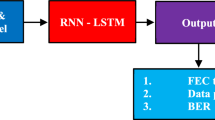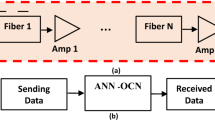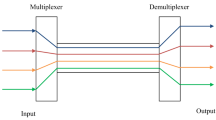Abstract
Due to the advancement of high definition, 5G technologies, the Internet of Things, and Artificial Intelligence, the demand for optical networks has increased widely. Optical communication networks offer various metrics, including high transmission capacity, efficient anti-interference, minimum transmission loss and robustness, and so on, that offer opportunities for communication networks. To satisfy the optical network demands, effective network resource utilization is essential. Therefore, develo** a tool with improved Quality of Transmission (QoT) accuracy in optical networks is necessary. Recently, Artificial intelligence (AI) approaches have provided various opportunities to resolve these issues and the deep learning (DL) algorithms offer improved performance over the conventional methods. This paper developed a novel DL-based cognitive QoT prediction model for Quantum optical communication networks. This proposed model predicts the QoT for the QoS (Quality of Service) setup using the DL model with the transmission computation. The proposed model utilized an optimized DL model called CNN-LSTM for the prediction process using the signal and link characteristics as input features. The DL model is trained using the transmission equations. The hyperparameters of the neural network are optimized using frog leap optimization to improve the predictive performance. The experimental results highlight the enhanced and improved version of the proposed model, and the results are compared with the conventional systems in terms of performance measures.






Similar content being viewed by others
Data availability
The datasets used and/or analyzed during the current study are available from the corresponding author upon reasonable request.
References
Amirabadi, M. A.: A survey on machine learning for optical communication [machine learning view]. (2019)
Cao, B., Zhao, J., Yang, P., Gu, Y., Muhammad, K., Rodrigues, J.J.P.C., de Albuquerque, V.H.C.: Multiobjective 3-D topology optimization of next-generation wireless data center network. IEEE Transact. Ind. Inf. 16(5), 3597–3605 (2020)
Cao, K., Wang, B., Ding, H., Lv, L., Tian, J., Hu, H., Gong, F.: Achieving reliable and secure communications in wireless-powered NOMA systems. IEEE Transact. Veh. Technol. 70(2), 1978–1983 (2021)
Cao, K., Ding, H., Li, W., Lv, L., Gao, M., Gong, F., Wang, B.: On the ergodic secrecy capacity of intelligent reflecting surface aided wireless powered communication systems. IEEE Wirel. Commun. Lett. 11(11), 2275–2279 (2022)
Cheng, B., Zhu, D., Zhao, S., Chen, J.: Situation-aware IoT service coordination using the event-driven SOA paradigm. IEEE Transact. Netw. Serv. Manag. 13(2), 349–361 (2016)
Dai, X., **ao, Z., Jiang, H., Alazab, M., Lui, J.C., Dustdar, S., Liu, J.: Task co-offloading for D2D-assisted mobile edge computing in industrial internet of things. IEEE Transact. Ind. Inf. 19(1), 480–490 (2022)
Ding, G., Anselmi, N., Xu, W., Li, P., Rocca, P.: Interval-bounded optimal power pattern synthesis of array antenna excitations robust to mutual coupling. IEEE Antennas Wirel. Propag. Lett.Wirel. Propag. Lett. 22(11), 2725–2729 (2023)
Dong, Z., Khan, F.N., Sui, Q., Zhong, K., Lu, C., Lau, A.P.T.: Optical performance monitoring: a review of current and future technologies. J. Lightw. Technol. 34(2), 525–543 (2015)
Gao, J., Wu, D., Yin, F., Kong, Q., Xu, L., Cui, S.: MetaLoc: learning to learn wireless localization. IEEE J. Select. Areas Commun. (2023)
Han, Y., Wang, B., Guan, T., Tian, D., Yang, G., Wei, W., Chuah, J.H.: Research on road environmental sense method of intelligent vehicle based on tracking check. IEEE Transact. Intell. Transp. Syst. 24(1), 1261–1275 (2022)
Jiang, Y., Li, X.: Broadband cancellation method in an adaptive co-site interference cancellation system. Int. J. Electron. 109(5), 854–874 (2022)
Jiang, H., **ao, Z., Li, Z., Xu, J., Zeng, F., Wang, D.: An energy-efficient framework for internet of things underlaying heterogeneous small cell networks. IEEE Transact. Mobile Comput. 21(1), 31–43 (2022d)
Jiang, S., Zhao, C., Zhu, Y., Wang, C., Du, Y., Lei, W., Wang, L.: A practical and economical ultra-wideband base station placement approach for indoor autonomous driving systems. J. Adv. Transp. 1–12, (2022)
Jiang, Y., Liu, S., Li, M., Zhao, N., Wu, M.: A new adaptive co-site broadband interference cancellation method with auxiliary channel. Dig. Commun. Netw. (2022)
Jiang, H., Dai, X., **ao, Z., & Iyengar, A. K.: Joint task offloading and resource allocation for energy-constrained mobile edge computing. IEEE Transact. Mobile Comput. (2022)
Li, A., Masouros, C., Swindlehurst, A.L., Yu, W.: 1-bit massive MIMO transmission: embracing interference with symbol-level precoding. IEEE Commun. Mag.Commun. Mag. 59(5), 121–127 (2021)
Li, J., Deng, Y., Sun, W., Li, W., Li, R., Li, Q., Liu, Z.: Resource orchestration of cloud-edge–based smart grid fault detection. ACM Transact. Sens. Netw. (TOSN) 18(3), 1–26 (2022)
Li, S., Chen, H., Chen, Y., **ong, Y., Song, Z.: Hybrid method with parallel-factor theory, a support vector machine, and particle filter optimization for intelligent machinery failure identification. Machines 11(8), 837 (2023)
Li, D., Ortegas, K.D., White, M.: Exploring the computational effects of advanced deep neural networks on logical and activity learning for enhanced thinking skills. Systems 11(7), 319 (2023)
Li, L., Yao, L.: Fault tolerant control of fuzzy stochastic distribution systems with packet dropout and time delay. IEEE Transact. Autom. Sci. Eng. (2023)
Liu, G.: Data collection in MI-assisted wireless powered underground sensor networks: directions, recent advances, and challenges. IEEE Commun. Mag.Commun. Mag. 59(4), 132–138 (2021)
Liu, G.: A Q-Learning-based distributed routing protocol for frequency-switchable magnetic induction-based wireless underground sensor networks. Futur. Gener. Comput. Syst.. Gener. Comput. Syst. 139, 253–266 (2023)
Liu, X., Lun, H., Fu, M., Fan, Y., Yi, L., Hu, W., Zhuge, Q.: AI-based modeling and monitoring techniques for future intelligent elastic optical networks. Appl. Sci. 10, 363 (2020)
Liu, D., Cao, Z., Jiang, H., Zhou, S., **ao, Z., Zeng, F.: Concurrent low-power listening: a new design paradigm for duty-cycling communication. ACM Transact. Sens. Netw. 19(1), 1–24 (2022)
Luo, J., Zhao, C., Chen, Q., Li, G.: Using deep belief network to construct the agricultural information system based on Internet of Things. J. Supercomput.Supercomput. 78(1), 379–405 (2022)
Lyu, T., Xu, H., Zhang, L., Han, Z.: Source selection and resource allocation in wireless powered relay networks: an adaptive dynamic programming based approach. IEEE Intern. Things J. (2023)
Ma, K., et al.: Reliability-constrained throughput optimization of industrial wireless sensor networks with energy harvesting relay. IEEE Intern. Things J. 8(17), 13343–13354 (2021)
Mata, J., de Miguel, I., Duran, R.J., Merayo, N., Singh, S.K., Jukan, A., Chamania, M.: Artificial intelligence (AI) methods in optical networks: a comprehensive survey. Opt. Switch. Netw.Netw. 28, 43–57 (2018)
Min, H., Li, Y., Wu, X., Wang, W., Chen, L., Zhao, X.: A measurement scheduling method for multi-vehicle cooperative localization considering state correlation. Veh. Commun. 44, 100682 (2023)
Pointurier, Y.: Design of low-margin optical networks. J. Opt. Commun. Netw. 9(1), A9–A17 (2017)
Qiu, Y., Shi, M., Guo, X., Li, J., Wu, J., Zhou, Y., Li, Y.: Sensitivity improvement in the measurement of minor components by spatial confinement in fiber-optic laser-induced breakdown spectroscopy. Spectrochim. Acta Part B at. Spectrosc. 209, 106800 (2023a)
Qiu, Y., Guo, X., Shi, M., Zhou, Y., Wu, J., Li, J., Li, Y.: Plasma dynamics and chlorine emission characteristics on cement pastes using collinear dual-pulse laser-induced breakdown spectroscopy. Spectrochim. Acta Part B at. Spectrosc. 209, 106799 (2023b)
Qu, J., Mao, B., Li, Z., Xu, Y., Zhou, K., Cao, X., Wang, X.: Recent progress in advanced tactile sensing technologies for soft grippers. Adv. Funct. Mater.Funct. Mater. 33(41), 2306249 (2023a)
Qu, J., Yuan, Q., Li, Z., Wang, Z., Xu, F., Fan, Q., Xu, M.: All-in-one strain-triboelectric sensors based on environment-friendly ionic hydrogel for wearable sensing and underwater soft robotic gras**. Nano Energy 111, 108387 (2023b)
Shi, J., Niu, W., Li, Z., Shen, C., Zhang, J., Yu, S., Chi, N.: Optimal adaptive waveform design utilizing an end-to-end learning-based pre-equalization neural network in an UVLC system. J. Lightw. Technol. 41(6), 1626–1636 (2023a)
Shi, J., Li, Z., Jia, J., Li, Z., Shen, C., Zhang, J., Chi, N.: Waveform-to-waveform end-to-end learning framework in a seamless fiber-terahertz integrated communication system. J. Lightw. Technol. 41(8), 2381–2392 (2023b)
Singh, H., Ramya, D., Rengaraj, S., Sateesh, N., Anand, R., Singh, S., Subramani, N.: Artificial intelligence based quality of transmission predictive model for cognitive optical networks. Optik 257, 168789 (2022). https://doi.org/10.1016/j.ijleo.2022.168789
Tizikara, D.K., Serugunda, J., Katumba, A.: Machine learning-aided optical performance monitoring techniques: a review. Front. Commun. Netw. 2, 756513 (2022)
Ujjwal, J.T., Barreto, A.A.D.: Accurate QoT estimation for the optimized design of optical transport network based on advanced deep learning model. Opt. Fiber Technol. 70, 102895 (2022). https://doi.org/10.1016/j.yofte.2022.102895
Wang, K., Zhang, B., Alenezi, F., Li, S.: Communication-efficient surrogate quantile regression for non-randomly distributed system. Inf. Sci. 588, 425–441 (2022)
Wang, Q., Li, P., Rocca, P., Li, R., Tan, G., Hu, N., Xu, W.: Interval-based tolerance analysis method for petal reflector antenna with random surface and deployment errors. IEEE Transact. Antennas Propag. 71(11), 8556–8569 (2023)
Wen, C., Huang, Y., Zheng, L., Liu, W., Davidson, T.N.: Transmit waveform design for dual-function radar-communication systems via hybrid linear-nonlinear precoding. IEEE Trans. Signal Process. 71, 2130–2145 (2023a)
Wen, C., Huang, Y., Davidson, T.N.: Efficient transceiver design for MIMO dual-function radar-communication systems. IEEE Trans. Signal Process. 71, 1786–1801 (2023b)
Xu, H., Han, S., Li, X., Han, Z.: Anomaly traffic detection based on communication-efficient federated learning in space-air-ground integration network. IEEE Transact. Wirel. Commun. 99, 1–1 (2023)
Yang, M., Liu, W., Liu, Z., Cai, C., Wang, Y., Yang, J.: Binocular vision-based method used for determining the static and dynamic parameters of the long-stroke shakers in low-frequency vibration calibration. IEEE Transact. Ind. Electron. 70(8), 8537–8545 (2023)
Yao, Y., Shu, F., Li, Z., Cheng, X., Wu, L.: Secure transmission scheme based on joint radar and communication in mobile vehicular networks. IEEE Transact. Intell. Transp. Syst. (2023)
Zhang, Y., He, Y., Wang, H., Sun, L., Su, Y.: Ultra-broadband mode size converter using on-chip metamaterial-based Luneburg lens. ACS Photon. 8(1), 202–208 (2021)
Zhang, Y., Zhao, P., Lu, Q., Zhang, Y., Lei, H., Yu, C., Yu, J.: Functional additive manufacturing of large-size metastructure with efficient electromagnetic absorption and mechanical adaptation. Compos. Part A: Appl. Sci. Manuf. 173, (2023)
Zhang, C., Zhou, L., Li, Y.: Pareto optimal reconfiguration planning and distributed parallel motion control of mobile modular robots. IEEE Transact. Ind. Electron. (2023)
Zhao, C., Cheung, C.F., Xu, P.: High-efficiency sub-microscale uncertainty measurement method using pattern recognition. ISA Transact. 101, 503–514 (2020)
Zhao, Z., Xu, G., Zhang, N., Zhang, Q.: Performance analysis of the hybrid satellite-terrestrial relay network with opportunistic scheduling over generalized fading channels. IEEE Transact. Veh. Technol. 71(3), 2914–2924 (2022)
Zhou, G., Zhang, R., Huang, S.: Generalized buffering algorithm. IEEE Access 9, 27140–27157 (2021)
Funding
This research received no specific grant from any funding agency.
Author information
Authors and Affiliations
Contributions
YZ: Conceptualization, Methodology, Formal analysis, Validation, Resources, Supervision, Writing—original draft, Writing—review & editing.
Corresponding author
Ethics declarations
Conflict of interest
The authors declare that they have no competing interests.
Ethical approval
Not applicable.
Consent for publication
Not applicable.
Additional information
Publisher's Note
Springer Nature remains neutral with regard to jurisdictional claims in published maps and institutional affiliations.
Rights and permissions
Springer Nature or its licensor (e.g. a society or other partner) holds exclusive rights to this article under a publishing agreement with the author(s) or other rightsholder(s); author self-archiving of the accepted manuscript version of this article is solely governed by the terms of such publishing agreement and applicable law.
About this article
Cite this article
Zeng, Y. Quantum optical techniques for quality data transmission process in cognitive networks. Opt Quant Electron 56, 414 (2024). https://doi.org/10.1007/s11082-023-06062-3
Received:
Accepted:
Published:
DOI: https://doi.org/10.1007/s11082-023-06062-3




